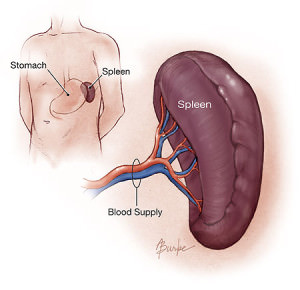 The spleen is a deep purple, moon-shaped organ that is located in the left upper part of the abdomen. The size of the spleen varies amongst individuals but in general is approximately the size of a half grapefruit.
The spleen is a deep purple, moon-shaped organ that is located in the left upper part of the abdomen. The size of the spleen varies amongst individuals but in general is approximately the size of a half grapefruit.
Although not a vital organ, the spleen is very important in the development and maintenance of the immune response. The organ has a tremendous blood supply underscoring its important role in “filtering” the blood. The spleen allows the body to recognize bacterial invasions and specifically helps eliminate encapsulated bacteria such as S. pneumonia, N. meningitidis and H influenza.
In addition, the spleen helps remove and recycle red blood cells as they age. The erythrocyte, aka red blood cell, normally exhibits a biconcave shape. When red blood cells age or in the case of an inherited disorder the shape of the red blood cell changes. The abnormal red cells are sequestered in the spleen, broken down and their components recycled.
Disorders of the spleen
There are certain pathological states that lead to enlargement of the spleen, chronic anemia (low red blood cell counts) and in some cases low platelet counts. When this occurs patients may experience pain in the left upper quadrant and signs or symptoms of anemia or bleeding. These conditions may be benign or malignant. They may also be self-limited or chronic. Below is a brief list of conditions that may warrant splenectomy.
- Benign disease:
- ITP (immune thrombocytopenic purpura)
- hereditary spherocytosis
- sickle cell disease
- thalassemia
- splenic abscess
- trauma
- large splenic cysts
- Malignant disease:
- lymphomas
Laparoscopic Splenectomy
The spleen can be removed from the body using a laparoscopic approach. The procedure is performed under general anesthesia. The biggest determinant for laparoscopic splenectomy is the size of the spleen. Occasionally pre-operative angioembolization is used to shrink the spleen and reduce the potential for major blood loss. This entails a radiology guided procedure where the splenic artery is occluded thereby diminishing blood flow to the spleen and causing the spleen to contract in size. Massive spleens may require an open incision in order to extract the organ from the body.
Approximately 15% of people have “accessory spleens”. These are small implants of splenic tissue that are not directly connected to the main organ. Identification and removal of accessory spleens is necessary to correct many of the diseases that are an indication for splenectomy. The magnification provided by laparoscopic surgery helps the surgeon find and excise these small implants.
In the case of large splenic cysts that are causing symptoms a total splenectomy is rarely necessary. Often, using a laparoscopic approach, the cysts can be excised leaving an intact spleen and preserving splenic function.
The benefits of a laparoscopic approach are:
- Shorter hospital stay
- Less post-surgical pain
- Reduced incidence of incisional hernia
- Earlier return to regular diet
- Earlier return to work/full activities
Should you require a splenectomy a detailed set of both pre and post-operative instructions will be provided at the time of your visit.
